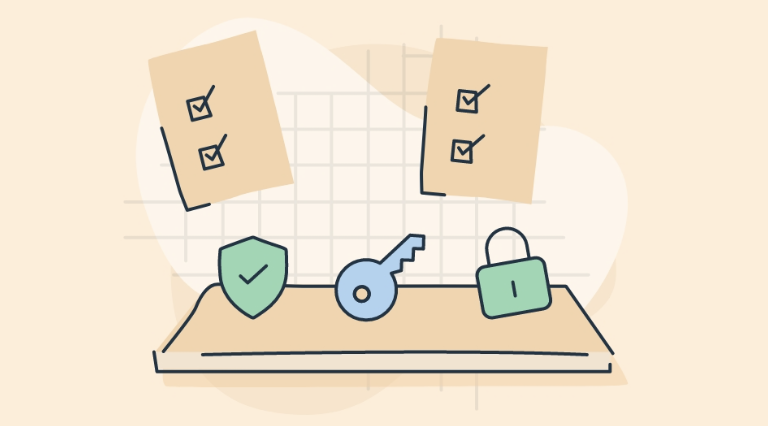National Cybersecurity Strategy (NCS) and its implementation plan (NCSIP): Quick highlights…
Heard about the NCS23 and NCSIP? No!? Don't worry here's a blog that covers it all for you. Enjoy!

Get fresh insights, pro tips, and thought starters–only the best of posts for you.
Alie Ashryver
Sep 4, 2023
11 min read

Eight months into 2023, and we already have numbers and stats pouring in from around the world. We have numbers and reports highlighting the average cost of a data breach in 2023. Well, if we are to believe IBM’s research, then the number stands at a little under 4.5 million USD. No amount of anxious coffee-sipping will take away from the fact that this number means a staggering 15% increase over the last three years. Quite the jump! In fact, cybercriminals are becoming more and more brazen. They are fine-tuning their skills by weaving in AI and machine learning.
So, why exactly is cybersecurity so important? That’s the question. Well, there’s the obvious reason – securing cyberspace. As organizations and enterprises become increasingly dependent on digital technologies, and, more importantly, the INTERNET, cybersecurity is rising in priority. If that’s not enough to convince you, (as it shouldn’t be 😌) here are some other reasons that might move you.
Organizations handle a significant amount of sensitive and confidential data. These include anything and everything from customer information and financial records to intellectual property and trade secrets. A breach in cybersecurity could lead to the loss or theft of this data. And the next thing you know, you are drowning in financial losses and legal liabilities. Consequently, your organization’s reputation suffers.
In an era of data privacy regulations and heightened consumer awareness, maintaining the trust of customers is essential. A cybersecurity incident can erode trust and loyalty, thus motivating customers to take their business elsewhere.
Data Privacy and Data Security: the connection and distinction
Many industries are subject to stringent data protection regulations, such as the General Data Protection Regulation (GDPR) in Europe or the Health Insurance Portability and Accountability Act (HIPAA) in the healthcare sector. Moreover, significant fines and messy lawsuits are the direct consequences of non-compliance with these regulations.
Cyberattacks can disrupt essential business operations. Consequently, leading to downtime, loss of productivity, and financial losses. A well-executed cyberattack can render an organization’s systems and networks inoperable, causing disruption to day-to-day activities.
As more and more financial transactions occur online, organizations must ensure the security of payment systems and online transactions. Breaches in these systems blow open the door for fraudulent activities, financial loss, and reputational damage.
Enterprises invest significant resources in developing intellectual property, such as patents, copyrights, and trademarks. Cyberattacks aimed at stealing or sabotaging this valuable information can result in competitive disadvantages and lost market opportunities.
Organizations are vulnerable to cyber espionage, where adversaries attempt to gain access to sensitive information, including trade secrets and proprietary information. Consequently, this can lead to a loss of competitive advantage and potential damage to national security in certain cases.
Organizations often collaborate with various suppliers, vendors, and partners. Basically, a weaknesses in the cybersecurity of one entity within the supply chain can have a cascading effect, potentially compromising the security of the entire ecosystem.
Insider threats, whether intentional or accidental, pose a significant risk. In fact, employees, contractors, or other insiders with access to sensitive systems can inadvertently or deliberately compromise security.
So, you see, there are a lot of reasons why cybersecurity is a critical priority. But then again, what all does cybersecurity entail?
It encompasses a range of technologies, processes, practices, and measures designed to safeguard the confidentiality, integrity, and availability of digital information and systems. The central objective of cybersecurity is to safeguard digital resources and mitigate the consequences of cyberattacks, aiming to maintain their security. In fact, cybersecurity involves various components and strategies, including:
Well, cybersecurity is a constantly evolving field due to the dynamic nature of cyber threats and the rapid advancements in technology. New attack methods emerge, and cyber criminals continuously adapt their tactics, making it crucial for organizations to stay up-to-date with the latest security measures and practices. Also, cybersecurity plays a critical role in protecting sensitive information, maintaining operational continuity, and building trust among customers, partners, and stakeholders in today’s digital age.
So, I realized something after countless sessions of internet surfing and sifting through a gazillion articles flagged for the keyword ‘cybersecurity.’ The concept of cybersecurity, as such, is vast, and its functionality is widespread. But, be that as it may, it’s not entirely outside the scope of our understanding. And so, here we are…
Basically, organizations need to integrate these functions into their cybersecurity strategy to establish a robust defense against the looming titan of cyber threats.
Ooookay, now that all of that is out of the way, let’s get down to business. What can organizations do to notch up their cybersecurity infrastructure? Well, here’s a look at the cybersecurity essentials for any organization or enterprise.

Need a hand with adopting the best possible cybersecurity strategy for your organization? Have a look at this resource kit.
Download kitDeploy network firewalls to control incoming and outgoing network traffic. And thus prevent unauthorized access!
Keep operating systems, applications, and software up to date with the latest security patches to address known vulnerabilities.
Implement multi-factor authentication (MFA) for accessing systems and sensitive data. And so, you can easily add an extra layer of security beyond passwords.
Limit user access to only the resources and data they need for their roles (RBAC). You can also try to apply the principle of least privilege (PoLP).
Encrypt sensitive data both at rest and in transit using strong encryption protocols to prevent unauthorized access.
Apply secure configurations to endpoints, disabling unnecessary services and features that could be exploited.
Implement network segmentation to isolate different types of endpoints. And thus, limit lateral movement in case of a breach.
Ensure that remote access to corporate resources is secured using encrypted VPN connections and other secure remote access solutions.
Implement measures such as web application firewalls (WAFs) to protect against attacks targeting web applications.
Use application allowlisting to allow only approved applications to run on endpoints, reducing the risk of unauthorized or malicious software.
Utilize MDM and MAM solutions to manage and secure mobile devices, apps, and data. Additionally, these solutions offer capabilities like enforcing security policies and remote wiping.
Implement RMM tools to monitor and manage endpoints remotely, enabling quick response to security incidents.
Deploy DLP solutions to prevent unauthorized data leakage or transfer from endpoints.
Regularly back up critical data and systems to ensure data recovery in case of ransomware attacks or other data loss incidents.
Develop and regularly update an incident response plan that outlines steps to take in the event of a cybersecurity incident.
Continuously educate users about emerging threats and best practices to maintain a security-conscious environment.
Stay informed about industry-specific regulations and compliance requirements related to data security and privacy.
Whew! That’s a long list, isn’t it? But, what if you could just invest your time, energy, and money in a single solution that could handle all of this for you? Wouldn’t that be great? Well, you’re in luck! Unified Endpoint Management (UEM) solutions like Hexnode can easily take care of all these and more.
Hexnode is a robust Unified Endpoint Management (UEM) solution that can help organizations check their cybersecurity essentials list with ease. By integrating a range of powerful features and capabilities, Hexnode empowers organizations to safeguard their endpoints, secure sensitive data, and fortify their cybersecurity posture. Accordingly, it offers a centralized hub for managing a diverse array of endpoints, including computers, mobile devices, tablets, and even IoT devices. This comprehensive control enables organizations to monitor, manage, and secure their entire digital ecosystem from a single interface.
With the ability to deploy and manage security configurations, including those for BitLocker, FileVault, etc., Hexnode ensures that endpoints remain fortified against a broad spectrum of cyber threats. Hexnode also simplifies the critical task of OS update management by automating the installation of OS updates. And so, this ensures that endpoints remain up to date with the latest software updates and security fixes, thereby closing potential vulnerabilities exploited by cybercriminals.
Moreover, Hexnode’s reporting and monitoring functionalities enable organizations to perform regular audits, ensuring compliance with cybersecurity standards and regulations. The ability to analyze and track device activities provides valuable insights to detect and address potential security anomalies.
Cybersecurity is a constantly evolving field due to the dynamic nature of cyber threats and the rapid advancements in technology. Consequently, new attack methods emerge, and cyber criminals continuously adapt their tactics, making it crucial for organizations to stay up-to-date with the latest security measures and practices.
And so, we’ve come to the end of our musings on cybersecurity essentials. However, remember that these essentials serve as a foundation for creating a robust cybersecurity posture. Organizations should tailor their cybersecurity strategy based on their specific risks, industry, and technology environment.
How about trying Hexnode as a one-stop shop for all your cybersecurity essentials?
Join the tribe